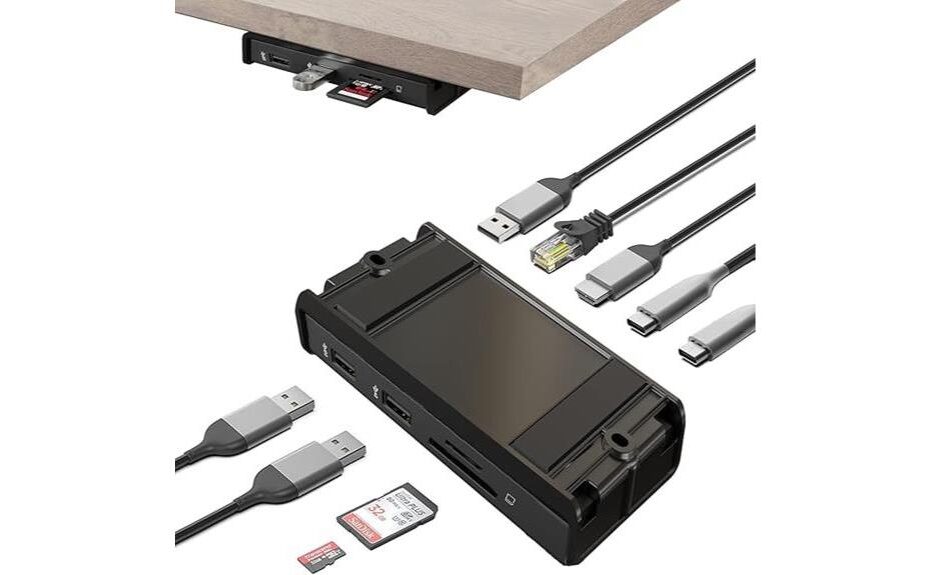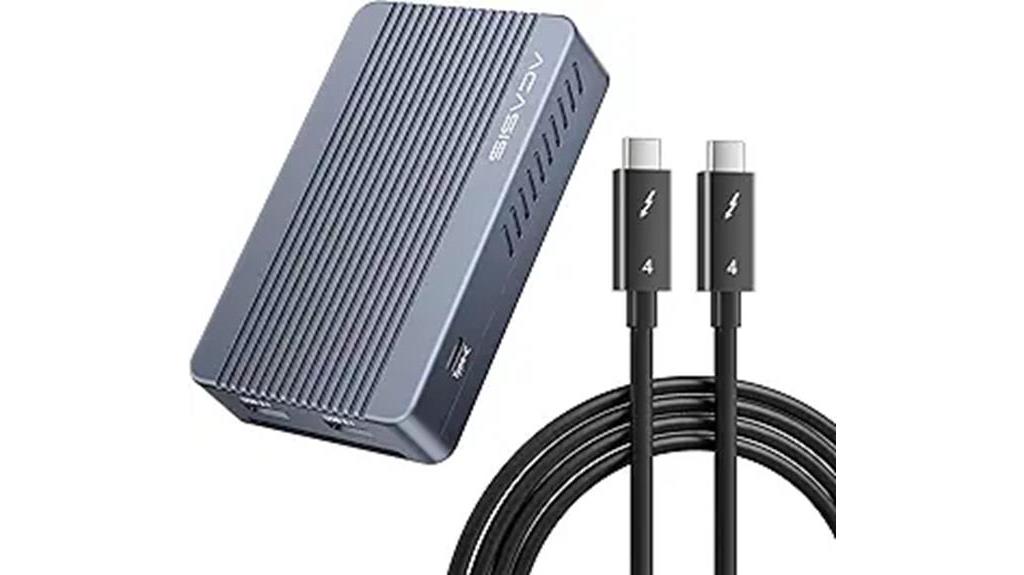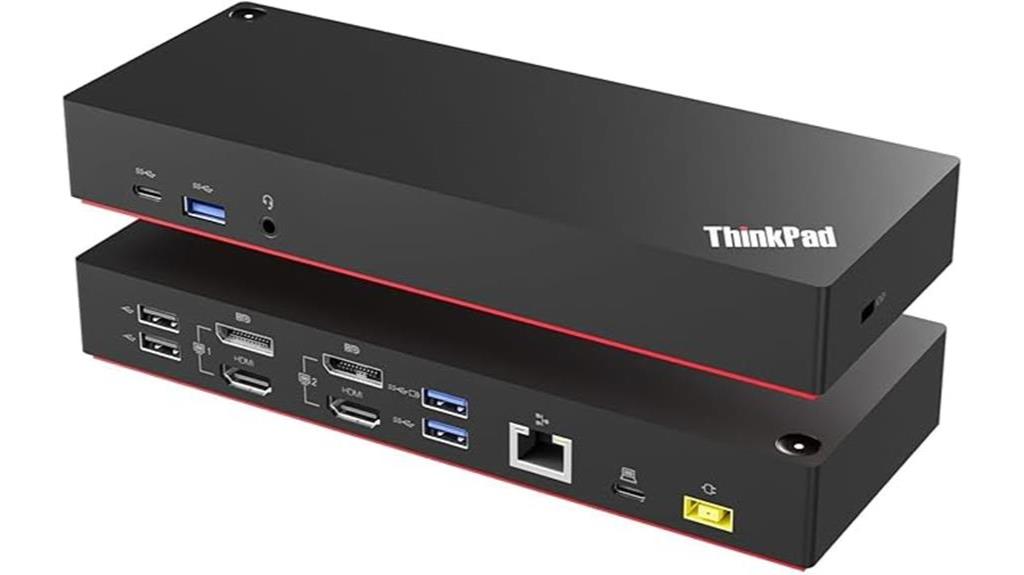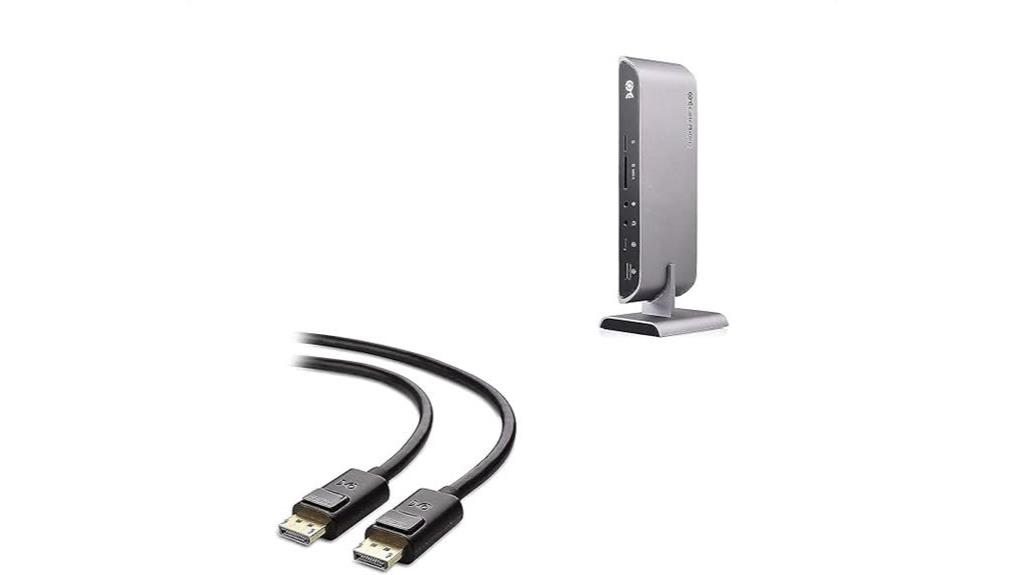

I recently reviewed the HumanCentric USB C Docking Station and found it to be a mixed bag. Installation is simple, thanks to the VHB tape, but some users struggle with HDMI performance and connectivity issues. It offers multiple USB-A ports and an 87W power delivery charger, enhancing overall functionality and organization. However, the product's plastic quality raised durability concerns. While many appreciate the clean, clutter-free workspace it provides, others report inconsistent performance. If you're considering this docking station, weighing its strengths and weaknesses against your needs might be essential. There's more to discover about its features and user experiences.
Key Takeaways
- The HumanCentric USB C Docking Station features multiple ports, including USB-A and HDMI, enhancing connectivity for various peripherals.
- Installation is straightforward and can be done using adhesive tape or screws, but may leave residue.
- Users report inconsistent HDMI output and potential connectivity drops, affecting overall performance.
- Under-desk mounting helps organize cables, improving workspace aesthetics and saving surface space.
- Overall product quality is questioned due to plastic components and varying user experiences regarding durability.
When considering the HumanCentric USB C Docking Station, it's essential to analyze its key features and overall design. I found the installation straightforward, especially with the included VHB adhesive tape or wood screws for sturdy mounting. A tip I'd recommend is ensuring the surface is at least 3/4 inches thick for the best adhesion. When connecting, I made sure to use the correct USB-C ports—one for the wall charger and the other for my laptop. If you encounter issues, like HDMI output inconsistencies, I suggest checking cable connections and ensuring your laptop settings are correct. Overall, having solid installation tips and troubleshooting advice handy can really enhance the user experience with this docking station.
Features and Benefits
The HumanCentric USB C Docking Station offers several features that enhance both organization and functionality. I appreciate the under-desk mounting option, which keeps my workspace tidy, while the 87W power delivery charger guarantees my laptop stays powered. With multiple USB-A ports and a single HDMI display output, I find it easy to connect my peripherals and enjoy a streamlined setup.
Under-Desk Mounting for Organization
Mounting the HumanCentric USB C Docking Station under my desk has transformed my workspace into a more organized and efficient environment. By keeping the docking station out of sight, I've greatly improved my cable management. No longer do I have to deal with a tangled mess of cords snaking across my desktop, which enhances my desk aesthetics. The under-desk installation not only saves valuable surface space but also creates a clean, professional look. This setup allows me to access my devices easily while maintaining a clutter-free workspace. Overall, the under-desk mounting feature is a practical solution for anyone looking to streamline their work area and enjoy a more visually appealing environment.
7W Power Delivery Charger
While using the HumanCentric USB C Docking Station, I've found the 87W Power Delivery Charger to be a standout feature that greatly enhances the overall user experience. This charger excels in power management, ensuring my devices receive peak wattage for efficient charging. With its robust design, it delivers power quickly and reliably, which is essential for my workflow, especially during intensive tasks. I appreciate the charging efficiency it provides, allowing my laptop to maintain performance without interruptions. Furthermore, the under-desk mounting keeps my workspace tidy, eliminating cable clutter while still accessing the charger easily. Overall, this feature not only simplifies my setup but also maximizes productivity through seamless power delivery.
Multiple USB-A Ports
Having multiple USB-A ports on the HumanCentric USB C Docking Station greatly enhances its functionality, allowing me to connect various peripherals simultaneously. The USB A versatility is a standout feature, enabling me to link devices such as external hard drives, keyboards, and mice without hassle. With three USB-A ports available, I can easily manage multiple peripherals at once, which streamlines my workflow. I appreciate that I don't need to constantly swap devices, making my setup more efficient. The ports support both USB 3.0 and USB 2.0, ensuring compatibility with a wide range of devices. Overall, the presence of these ports considerably boosts productivity and convenience, making the docking station a valuable addition to my workspace.
Single HDMI Display Output
The inclusion of a single HDMI display output on the HumanCentric USB C Docking Station provides a straightforward solution for connecting an external monitor. I appreciate its simplicity, but I've noticed some HDMI compatibility issues that could impact users, especially those with older laptops. While my setup worked seamlessly, some reviews mention inconsistent display performance, particularly with refresh rates—30Hz versus the desired 60Hz. This discrepancy can hinder productivity, especially for tasks requiring smooth visuals. Additionally, the short cable length may limit placement options. Overall, while the single HDMI output serves its purpose, potential users should be aware of these display performance concerns to guarantee it meets their specific needs.
Product Quality
Many users have expressed concerns about the overall product quality of the HumanCentric USB C Docking Station. I noticed that the build materials used in its construction have been a point of contention. While the design is sleek, some users report durability concerns, suggesting that the docking station may not withstand heavy daily use. The plastic components, in particular, seem less robust compared to competitors. Additionally, complaints about HDMI output inconsistencies and connection drops indicate potential weaknesses in the product's reliability. Overall, while it offers impressive features, the perceived quality and durability issues make me hesitant to fully endorse this docking station for long-term use. It's essential to weigh these factors against its functionality.
What It's Used For
The HumanCentric USB C Docking Station markedly enhances connectivity options, allowing me to connect multiple devices effortlessly. It also helps streamline my workspace, reducing cable clutter and creating a more organized environment. With its versatile compatibility, I can easily use it with various USB-C laptops, making it a practical choice for my setup.
Enhanced Connectivity Options
Enhanced connectivity options with the HumanCentric USB C Docking Station streamline my workspace by consolidating various peripherals into a single, efficient hub. I appreciate how it provides alternative connectivity through multiple USB-A ports, HDMI, and Ethernet, allowing me to connect everything I need without clutter. The user interface is intuitive; setting it up was quick, and I could easily plug in my laptop with just a USB-C cable. The inclusion of SD and Micro SD card readers adds further versatility, making file transfers hassle-free. However, I've noticed that some devices struggle with HDMI output consistency, which can be frustrating. Overall, the docking station greatly enhances my productivity by simplifying how I connect to my essential tools.
Streamlined Workspace Organization
Utilizing the HumanCentric USB C Docking Station has considerably transformed my workspace organization. With its streamlined design, I've achieved significant workspace optimization. By mounting the dock under my desk, I've eliminated cable chaos, creating a cleaner and more efficient work environment. The docking station consolidates multiple connections into a single USB-C cable, simplifying my setup and enhancing productivity. This level of cable management not only declutters my desk but also allows for easy access to ports whenever I need them. I can quickly connect my peripherals without rummaging through tangled wires. Overall, this docking station has improved my workspace aesthetics and functionality, making it an essential component of my daily routine.
Versatile Device Compatibility
Achieving a clutter-free workspace with the HumanCentric USB C Docking Station not only optimizes organization but also enhances compatibility with various devices. I've found it incredibly versatile, working seamlessly with my MacBook and Surface Pro. The device compatibility extends to multiple USB-C laptops, making it a valuable asset regardless of your brand preference. With its range of ports, I can connect my peripherals effortlessly, which greatly improves my user experience. However, I've noticed some users report inconsistencies with HDMI output and USB connectivity. While my setup remains reliable, it's crucial to take these factors into account. Overall, the docking station effectively meets my needs, providing a unified solution for my diverse devices without creating additional clutter.
Product Specifications
When examining the product specifications of the HumanCentric USB C Docking Station, you'll find a compact and efficient design tailored for modern laptops. The dock's dimensions and weight reflect thoughtful design considerations aimed at reducing desk clutter. However, users might face installation challenges due to varying surfaces.
Here's a quick overview:
| Specification | Details |
|---|---|
| Dimensions | 6.2 x 7.6 x 2.7 inches |
| Weight | 1.7 pounds |
| Ports | 2 USB-C, 1 HDMI, Ethernet, 3 USB A, SD & Micro SD |
These specifications highlight the dock's versatility while acknowledging that users must be mindful of their installation environment to guarantee peak performance.
Who Needs This
For anyone looking to streamline their workspace and enhance connectivity, the HumanCentric USB C Docking Station is a compelling option. This device primarily targets professionals and students who rely on USB-C laptops, such as MacBooks and Surface Pros. If you often work with multiple peripherals, like external monitors, keyboards, or SD cards, this docking station can simplify your setup. User scenarios include remote workers needing a clean workspace or creatives who require quick access to files via SD card readers. Additionally, anyone facing cable clutter will appreciate its under-desk mounting feature. Overall, if you value efficient connectivity and a tidy workspace, this docking station could greatly enhance your productivity.
Pros
One of the standout advantages of the HumanCentric USB C Docking Station is its ability to greatly declutter your workspace. The under-desk mounting option really enhances cable management, allowing me to keep my desk tidy. I appreciate how the user interface is streamlined; with just one USB-C connection, I can power my laptop while connecting multiple peripherals. Unlike some devices that suffer from occasional connectivity issues, I found this docking station to be reliable and consistent.
Here are some key pros I've noticed:
- Efficient cable organization reduces clutter and improves workspace aesthetics.
- Multiple ports provide versatile connectivity options for various devices.
- Easy installation makes setup a breeze, even for those not tech-savvy
Cons
Despite its many advantages, the HumanCentric USB C Docking Station isn't without its drawbacks. I've encountered some notable issues that potential buyers should consider. First off, there are installation challenges; while the adhesive tape is convenient, it often leaves residue and can be tricky to apply correctly. I also experienced performance issues, particularly with HDMI output consistency, which can be frustrating during essential tasks. Finally, the short cable lengths limit flexibility in setup, making it less than ideal for larger desks.
- Installation challenges with adhesive residue
- Inconsistent HDMI output performance
- Short cable lengths restrict setup options
What Customers Are Saying
While many customers appreciate the HumanCentric USB C Docking Station for its ability to streamline their workspace, feedback reveals a mix of satisfaction and frustration. In reviewing customer experiences, I noticed a common theme: users love the clean setup and the convenience of a single cable connection. However, several have reported performance issues, particularly with HDMI output and connectivity drops. Some struggle with short cable lengths and installation challenges, while others mention residue from adhesive stickers. Overall, the feedback indicates that while the docking station excels in organization and ease of use, its reliability varies greatly across different setups, leaving customers divided in their opinions.
Overall Value
Given the mixed feedback surrounding the HumanCentric USB C Docking Station, it's important to assess its overall value regarding functionality, build quality, and user satisfaction. My value analysis reveals that while it offers solid features like multiple ports and under-desk mounting, the performance has been inconsistent, particularly with HDMI output and connection stability. With respect to cost comparison, the price point sits in the mid-range for docking stations, which may not justify the investment for users facing frequent connectivity issues. Ultimately, if you're seeking a clean desk setup and can overlook some shortcomings, it could be worth it. However, if reliability is your primary concern, exploring alternatives might yield better results.
Tips and Tricks For Best Results
To maximize your experience with the HumanCentric USB C Docking Station, it's essential to follow a few practical tips. First, I recommend using the included VHB adhesive tape for a seamless installation under your desk, as it minimizes clutter. Make sure to connect the right USB-C power delivery port to the wall charger, ensuring consistent power. Based on user experiences, I've found that using a high-quality HDMI cable can help mitigate issues with output consistency. Additionally, keeping the docking station firmware updated can enhance compatibility with various devices. Finally, if you encounter installation difficulties, refer to the user manual for troubleshooting tips. These simple steps can greatly improve your overall experience with the docking station.
Conclusion
The HumanCentric USB C Docking Station presents a compelling solution for those seeking to streamline their workspace with effective connectivity options. However, my analysis of user experiences reveals a mixed bag. While I appreciate the clean desk setup and the convenience of a single cable connection, I can't ignore the installation challenges reported by some users. Issues like HDMI output inconsistency and short cable lengths have surfaced, detracting from the overall experience. Furthermore, connection drops and residue from installation stickers can frustrate new users. To sum up, while this docking station has solid features and potential, it is crucial to weigh these concerns against your specific needs and setup. It might be worth considering alternatives if you're particularly sensitive to these issues.
Frequently Asked Questions
How Does the Mounting Option Work for the Docking Station?
As I secured the docking station under my desk, the installation process felt like a puzzle piece clicking into place. The mounting stability keeps everything neat, eliminating the clutter and giving me easy access to ports.
Is the Docking Station Compatible With Non-Usb-C Laptops?
I've found that the docking station primarily supports USB-C laptops. While there are USB C alternatives for non-USB-C devices, compatibility isn't guaranteed, so I recommend checking specific requirements before purchasing.
Can the HDMI Output Support Multiple Displays?
It's ironic that while I crave a multi-monitor setup, the HDMI output only supports a single display resolution. I've learned that true productivity often requires more than what a single port can provide.
What Type of Adhesive Is Used for Mounting?
I've noticed that the mounting options for devices often include adhesive types like VHB tape or screws. These choices allow for secure positioning, but it's crucial to take into account the surface type for best adhesion.
How Does the Warranty Process Work for This Product?
When it comes to warranty coverage, I've found it's best to read the fine print. The return policy specifies the process for claiming issues, ensuring I'm covered if something goes awry with the product.
Disclosure: As an Amazon Associate, I earn from qualifying purchases.




